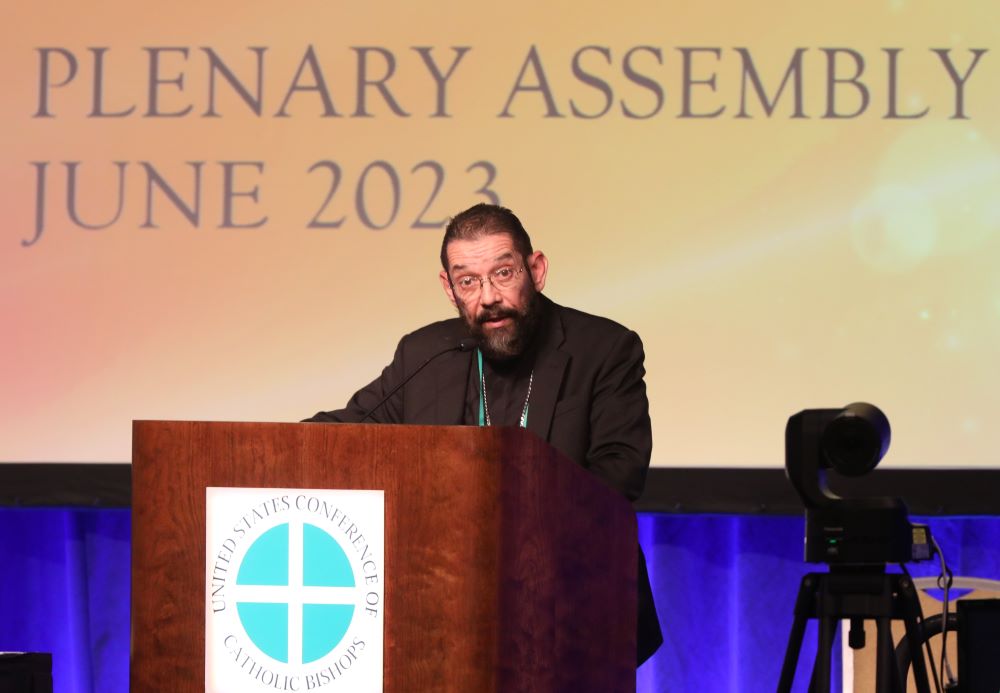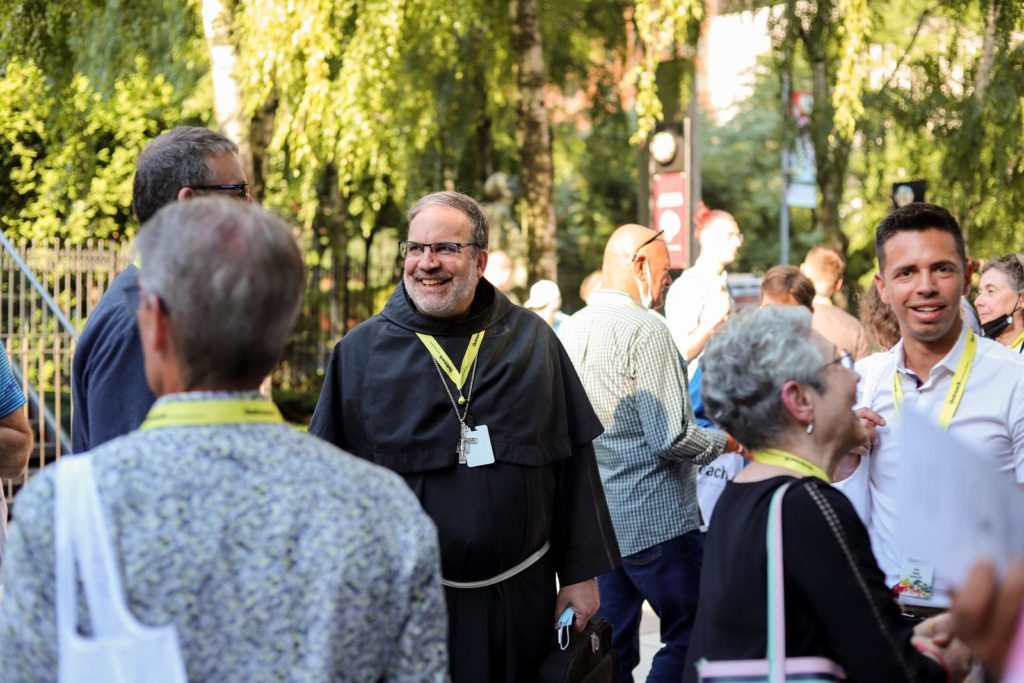A Bishop to Walk With
The panic was premature. They are talking about the Synod. Especially papal envoy Archbishop Christophe Pierre. Even USCCB President Broglio mentioned it. Bishop Cozzens, in explaining the Eucharistic Revival process in detail—2,400 parish point persons already! 25,000 registrants!—said it was kind of structured like a synod. (It’s actually structured like the corporation it is.) They’ve got the vocabulary. Do they have the process?
In April, Lexington Bishop John Stowe spoke about the Synod process to the Hank Center at Loyola Chicago, and Commonweal just published his text, perhaps as a not-so-subtle reminder to the bishops convening in Orlando—if they even read this lay-led magazine. I think it worked.
Reading this talk now, I am even more encouraged by Stowe’s honesty than I was in reading the summary at the time by Heidi Schlumpf in NCR. My expectations are low for bishops in general, but Stowe speaks what truth is for me without proclaiming that he’s doing it, in contrast to Broglio, who began his address to the bishops by repeating TRUTH over and over. Nuncio Pierre echoed some of Stowe’s points, so maybe Commonweal’s strategy was effective.

Bishop Daniel Flores did speak at the USCCB, apparently a late addition to the agenda. No text has been printed yet for his update on the Synod (though you can read a synopsis by Brian Fraga in NCR), but he did generate the only chuckle at the Thursday morning session. It was good-natured, after a chain that went something like this, from my notes: Many questions Diverse expectations. What is a synod? What is different about this one? What changes? Many questions. I will not answer them this morning. Chuckle.
Pierre added an example to a point Stowe also made effectively. “In these days of ‘GPS’ technology, when we ask, How do we get to where we’re going? we are accustomed to relying on turn-by-turn directions produced by an algorithm.” But the Synod is not that. Pierre continues: “It is less like GPS and more like a compass. The compass points to where ‘north’ is. You know the direction you need to take to arrive at your destination; but discerning how to get there requires close attention to your immediate surroundings, which involves patient and careful observation. So too, we as Church know the direction we are going: Jesus Christ and his Kingdom are the ‘true north’. But to find the proper path, we have to immerse ourselves in the reality of our people and listen carefully to the questions and concerns of their hearts. This is the synodal path; this is the incarnational way of Jesus.”
This is what Stowe said: “The dominant cultural pragmatism in North America was evident in the desire to know ‘where this is going.’ Bishops frequently stated that they do not know how to lead a process when the desired outcome of that process is unclear. I think the pope’s response to that complaint would be that the bishops are not meant to lead the process, but to facilitate the Holy Spirit’s guidance. [Emphasis added.] It is easy to see why the national ‘Eucharistic Revival’ has received far more energy, attention, and resources in the U.S. Church: there is a plan, there is marketing, there is a beginning and end point, there is substantial funding, and there is a problem to be addressed, namely the concern that Catholics do not believe sufficiently in the Real Presence. Instead of ensuring a eucharistic centrality to the synodal process, allowing for an organic discernment about our eucharistic understanding, plans for a mega-event featuring plenty of pre-conciliar piety and theology have replaced the focus on the Synod for a Synodal Church in the USCCB. It does not strike me as coincidental that much of the Eucharistic Revival focuses on eucharistic adoration, passive in nature, and so offers an easy alternative to the active engagement of walking together synodally.” [I will interrupt Stowe at this point to note there is also a Power Point, link above.]
To return to Stowe: “Several places in the United States could not resist creating a local action plan for their synod, even though this is clearly not the stage of the synod for that. Sometimes that push for a plan was about making sure that the insights gleaned from the People of God in dialogue would not be lost; I think that concern is valid, but also comes from thinking that the synod is an event rather than the way of being Church.”
See what I mean about honesty? See what Stowe means about Synod? See how good an example Pierre provides? And where is your TRUTH? Commonweal highlighted this quotation from Stowe about the Synod participants:
My own experience of sensing a palpable love for the Church, even when members have been frustrated, hurt, and are worried about its future, was echoed throughout the country and around the globe.

This is Stowe’s response to the Synod process. Schlumpf summarizes more of what he said: “despite frustrations and calls for change about issues including women’s roles and the place of LGBTQ people in the church. Many were grateful to have been listened to and expressed a desire for a more welcoming church.”
But I most admire his willingness to critique the North American summary, a document he helped frame. Schlumpf continues: “But during the continental meetings on Zoom, other concerns dominated the conversations, Stowe said. Among them, the bishop said, were:
- concerns about the ‘direction of the synod’;
- ‘questions about whether the synod was trying to change doctrine’ and ‘opposition to that possibility’;
- ‘calls for greater precision about what inclusivity might mean and who it might involve’;
- and ‘discussions of liturgical tensions and the loss of the Latin Mass.’
“Those concerns were even more pronounced during a special clerical listening session, also held by Zoom, created after the U.S. bishops’ conference staff noted the low participation of priests in the synod process, said Stowe. Each bishop was asked to name two priests — one older and one more recently ordained — for that session, which was ‘unofficial,’ Stowe said, and did not factor into the synthesis.”
If you remember that I quoted this in my blog on April 11, I am astonished. I found it refreshing then, as I find it now. Let’s pinpoint the interests of our bishops and clergy and how they differ from what the laity, who much more widely participated in the Synod process, had to say.
That’s enough. I hope you know I could have written about how the Southern Baptists rejected the churches that ordained women pastors. Or about the terrible vote by the USCCB to revise directives about transgender health care, so fearfully anticipated by Daniel Horan in NCR and many others. Or even about Massimo Faggioli’s “friendly response” to Joan Chittister’s reflections on Vatican II and Synodality, which I didn’t want to touch.
But when a member of our Philadelphia Commonweal discussion group sent us the text of Stowe’s address, I knew I wanted to acknowledge the Synod even if the USCCB wasn’t going to. Then they did; and I wonder if they know it’s as momentous as I think Vatican II was. I am glad to be participating in another historic moment for my church.

5 Responses
Let us pray that the “compass” points the way to the ordination of women.
Thanks for writing this, Regina. Stowe is an amazing bishop. In addition to his participation in the synod process, he is also the president-bishop of Pax Christi USA. I once sent him an email to thank him for something and he wrote back. I responded that I had never in my life gotten an email from a bishop. He responded that I should remember he’s not only a bishop, he’s a Franciscan. Yes!
Thank you for highlighting this bishop, his clarity and concerns, and willingness to listen. I would not have known about him other than superficially otherwise. I also like your point about his proposal that newly ordained and seasoned priests meet to discuss their Synod hopes and concerns since the results may give us a better idea of where and how we, the laity, and they, the clergy, differ or concur.
When I heard Bishop Stowe speak at the Outreach Catholic LGBTQ Ministry Conference at Fordham University in June 2022, I heard him say that he was not going to change anything. His main message was that God loves us as LGBTQ persons. Nothing new there. I have known God’s love for over 60 years. I was disappointed that Stowe failed to offer a message of hope for people living under the dark and dangerous cloud of the ecclesial designation that we are “intrinsically disordered.” That was not how our Creator created us when the Spirit breathed life into us. God’s order is greater and wider than some people imagine.
I am very glad you decided to focus on the positive–Bishop Stowe seems like a real breath of fresh ai in a group that seems very averse to opening any windows. I had not heard of him before, but I will listen for his name now, and hope to hear it more often than the bad news bishops. Speaking of bad news, I was not surprised that the Southern Baptists are trying to rid their ranks of churches with women pastors. Wonder how the misogynists among the Catholic bishops feel about their new comrades.